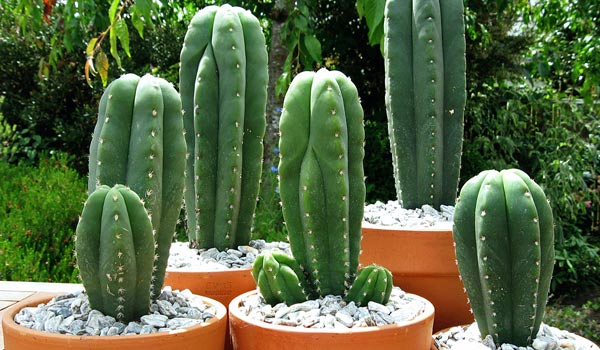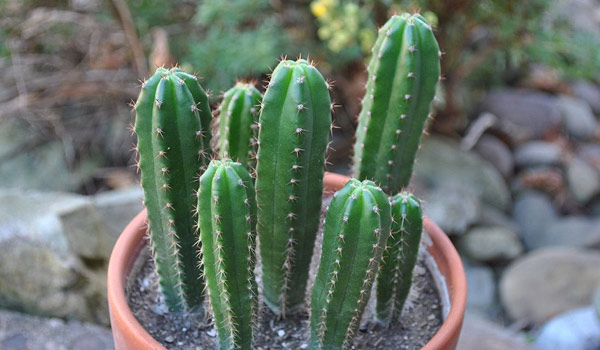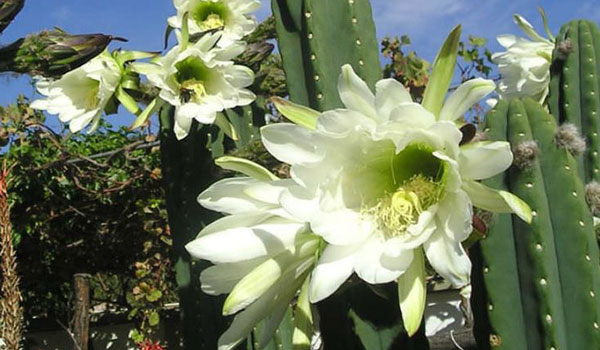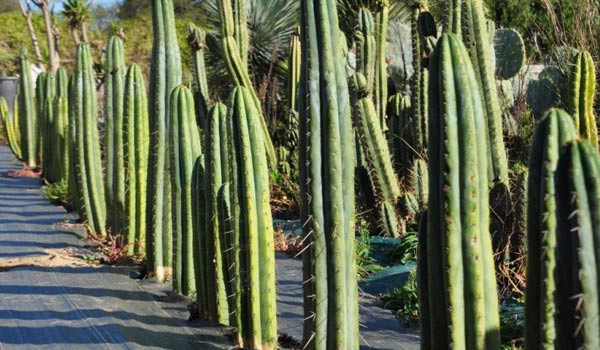Growing San Pedro Cactus (Trichocereus pachanoi)

Many of the cacti that we use today as ornamentals are native to Mexico. But the beautiful San Pedro cactus is actually from Argentina, Bolivia, Colombia, Chile, Ecuador, and Peru.
There is a good chance that you have seen this plant around and wondered about finding San Pedro cactus for sale, buying it, and bringing it to your home.
In the following, we are going to learn everything about this cactus; from growing San Pedro cactus seeds and cuttings to important care tips.

San Pedro Cactus Identification
Scientifically known as Echinopsis pachanoi and Trichocereus pachanoi, identifying this plant is actually quite simple if one knows some of its unique features.
As you expect, the most important one is its shape. This is a tubular cactus and usually has no arms. It has a pale green to blue-green color that becomes darker as it ages. If you look at its crowns, you will see that multiple stems can grow from only one crown.
The number of its vertical ribs can also help you with San Pedro cactus identification. It has 6 to 8 rounded ribs that run vertically along with the cactus. And on top of them, there are spikes to keep predators away.
San Pedro cactus flower can also help you in identifying it in a succulent collection. In July, you can see its white blooms that grow up to 9 or even 10 inches in diameter. These lovely fragrant flowers open at night when it is cooler.
If you have enough time, you can also monitor its growth rate for identification. Over a year, these cacti grow up to 1 foot. With a sturdy vertical shape, they can grow up to 10-20 feet in height and 5-6 feet in width.

Growing San Pedro Cactus from Seeds
Unlike some of the cacti that we know, it is very easy to propagate San Pedro cactus seeds. If you already have a mature plant, you can harvest its seeds.
You plant blooms in midsummer, but you have to wait until early autumn so its fruits are fully ripening. Then, all you need to do is removing the spongy matter inside the fruits and picking out the tiny black San Pedro cactus seeds.
If you do not have access to such a plant, buy the seeds from a reputable retailer. The seeds should be verified less than 10 years old. And remember that they are most viable within a year.
When you have the seeds, prepare the following equipment, and then you will be ready for growing San Pedro cactus from seeds. You will need a clear glass jar such as mason jars with the lid, a mix of sowing soil and fine sand, and a spray bottle.
Note: Using the right equipment, considerably increases your chance of successfully growing San Pedro cactus from seeds. You need to do this to prevent disease and infection. For example, using potting soil instead of the mentioned mix increases the risk of root rot.
You will need to:
- First of all, fill the bottom of the jar with the soil mix. Press the soil gently to level it and to provide a stable platform for the San Pedro cactus seeds.
- Place the seed on the soil, and mist the soil with water. Cover the container with the lid. If you cannot find the lid, use a transparent plastic wrap to cover the top.
- Place the jar in a sunny area with 77° to 86° F temperature (25° – 30° C). We do not recommend a spot with direct exposure to sunlight. If such a spot is not available, you can use a LED lamp (150 watts or higher).
- After 2 to 3 weeks, the seeds will germinate. Now you can transplant them into individual pots.
Tips:
- If a seed did not germinate after 6 weeks, or had signs of white mold, it means that it is dead. In this case, you need to dry the soil before planting a new seed.
- If you noticed any signs of fungus gnats, open the lid (or remove the plastic) to dry the space in the jar.
- Using the bottle sprayer, rinse any signs of the mold in the jar away and let it dry before covering the container again.

Propagating San Pedro Cactus Cuttings
An easier way for growing San Pedro cactus is rooting its cuttings. Before starting, keep in mind that multiple factors (such as the season, soil type, location, and amount of sunlight) determine the time that the cuttings need to begin rooting.
We recommend propagating in spring or summer. Because Echinopsis pachanoi, like many other plants, roots best in warm temperatures and soil.
For growing San Pedro cactus cuttings, follow these steps:
- After wearing suitable gloves, take a clean and sharp knife and cut off a piece (or pieces) at least as long as 12 inches. Large pieces will grow faster.
- Lay the cuttings on a tray covered with paper towels, and place the tray aside in a shady place until the bottom end of the cuttings dry. This process does not take longer than a few days in warm places. If not, you will need to wait for a week or so.
- When the cuttings have calloused, it means that they are ready to plant. Note that if the end is mushy or has rotted, cut that part and wait again.
- Prepare a container that has drainage holes, and fill it with rich and well-draining cactus soil mix. Spray the soil with water to make it moist and not wet.
- Gently place 2 to 3 inches of the San Pedro cactus cuttings in the soil. If you have cut a tall and heavy piece, it is a good idea to support it using a stick.
- Then, place the container in a dry and shady spot for 3 to 4 weeks until the roots appear. During this time, inspect everything closely. If the cutting looks rotten, bring it out, cut, and try again.
When the Trichocereus pachanoi roots, you can water it gently and pretty much treat it like a cactus of its own. In the next part, you can find this plant’s requirements.

San Pedro Cactus Care
You do not need to put a lot of effort to have a happy and healthy Echinopsis Pachanoi. Similar to many succulents, San Pedro cactus care is fairly simple.
Watering
After each irrigation, wait until the soil dries out a bit. Also, similar to other succulents, the San Pedro cactus goes dormant in cold seasons. So do not water it from October to April. Make sure to avoid overwatering, since soggy sustained soil can kill your cactus easier than you think.
Soil
As we mentioned, you need fertile potting soil with good drainage for growing San Pedro cactus. If the soil is also slightly acidic, your plant will grow best.
Fertilizing
During the growing season, you can feed the seedlings with a diluted mix of fertilizer occasionally. For mature cacti, you can use undiluted concentration with no problem.
Light
When older than one year, Trichocereus pachanoi can thrive in direct sun. However, direct sunlight can burn young seedlings. In general, this plant grows well in light shade during hot summers.
This plant is perfect for growing outdoors. So if you want to grow it indoors, make sure to provide enough sunlight for it.
Tip: After planting cuttings introduce them to the outdoor situation gradually
Temperature
A healthy San Pedro cactus tolerates temperatures are low as 50° F (10° C). It can also withstand occasional dips in the environment’s temperatures as low as 15.8° F (-9° C).
Pest or Disease
Overwatering Echinopsis Pachanoi in hot weather can lead to deadly fungal diseases and infections including damping-off, orange rot, and witches broom disease.
Root mealybugs and spider mites can also hurt your plant. You can deal with these pests with a neem oil spray. In the case of scales, you can simply scrub them (provided that you notice is early).
Black rot is another problem. But it is generally harmless and heals automatically after a short time.
Final Thoughts
This popular columnar cactus has a long history. There is archaeological evidence that shows healers in Andean culture, about 3000 years ago, used San Pedro cactus for medicinal and religious purposes.
With more than 20 different common names in Spanish (such as Andachuma, Gigantón, and Huachuma) and various species, these are not the only interesting facts about this plant.
You might have also heard about the San Pedro cactus powder. Some people do not simply grow this cactus for their desert gardens, succulent gardens, or rock gardens. It is also grown for an ingredient called mescaline, which is a controlled substance with psychoactive effects.
In many parts of the world (including the US), San Pedro cactus extraction and consumption of the mescaline is illegal, as well as trading it. Nevertheless, there is no doubt that this fast-growing cactus is going to be a great addition to your garden and home.


